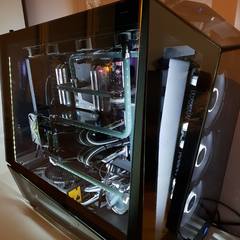-
Posts
5,174 -
Joined
-
Last visited
Reputation Activity
-
.png) Max_Settings got a reaction from lewdicrous in Breaking Wind News - Traceable toots
Max_Settings got a reaction from lewdicrous in Breaking Wind News - Traceable toots
Glad you caught wind of this news.
-
.png) Max_Settings got a reaction from Fnige in Breaking Wind News - Traceable toots
Max_Settings got a reaction from Fnige in Breaking Wind News - Traceable toots
Glad you caught wind of this news.
-
.png) Max_Settings got a reaction from Bazrat in Breaking Wind News - Traceable toots
Max_Settings got a reaction from Bazrat in Breaking Wind News - Traceable toots
Glad you caught wind of this news.
-
.png) Max_Settings got a reaction from Tech_Dreamer in Breaking Wind News - Traceable toots
Max_Settings got a reaction from Tech_Dreamer in Breaking Wind News - Traceable toots
Glad you caught wind of this news.
-
.png) Max_Settings got a reaction from Beskamir in Breaking Wind News - Traceable toots
Max_Settings got a reaction from Beskamir in Breaking Wind News - Traceable toots
Glad you caught wind of this news.
-
.png) Max_Settings got a reaction from Demolishdude in Breaking Wind News - Traceable toots
Max_Settings got a reaction from Demolishdude in Breaking Wind News - Traceable toots
Glad you caught wind of this news.
-
.png) Max_Settings got a reaction from TVwazhere in Breaking Wind News - Traceable toots
Max_Settings got a reaction from TVwazhere in Breaking Wind News - Traceable toots
Glad you caught wind of this news.
-
.png) Max_Settings got a reaction from drppr in Why people use MacOS?
Max_Settings got a reaction from drppr in Why people use MacOS?
This wouldn't even break top 1000 worst threads I've seen.
-
.png) Max_Settings got a reaction from lewdicrous in Why people use MacOS?
Max_Settings got a reaction from lewdicrous in Why people use MacOS?
This wouldn't even break top 1000 worst threads I've seen.
-
 Max_Settings got a reaction from Exaco in Why people use MacOS?
Max_Settings got a reaction from Exaco in Why people use MacOS?
I am not really an editor, but just speaking from experience of someone who is in the industry. I don't know anyone who uses Final Cut outside of youtubers and small creators. In the real world that is a joke like Sony Vegas.
-
 Max_Settings got a reaction from DrDerp in Misconceptions About "Neutral" Sound
Max_Settings got a reaction from DrDerp in Misconceptions About "Neutral" Sound
Agreed. And 9 times out of 10 the Youtuber also lacks context or basic knowledge of sound.
-
 Max_Settings got a reaction from DrDerp in Misconceptions About "Neutral" Sound
Max_Settings got a reaction from DrDerp in Misconceptions About "Neutral" Sound
One of the things that I often see people say when asking for a headphone recommendation is, "I want a neutral sound signature to hear the music the way the artist intended." However, this is very flawed logic. I also find a big misunderstanding among many people of what the term "neutral" means.
First let's start with a definition of what a neutral sound signature is. By basic definition, a neutral sound signature would be one where there is no emphasis on any part of the music. If you looked at a frequency response graph it would be just one flat line. The first thing you must understand is it is impossible to have a perfectly flat response without EQ. This goes for headphones are speakers. This is because so many factors. On headphones it is extremely difficult to tune something to be perfectly flat. Due to how driver tuning and dampening works, often when you tweak something, it changes something else, meaning it is basically impossible to have a dead flat headphone. Also other factors can change the sound such as the pads wearing down over time, this will affect the sound. Also someone with larger ears that take up more volume of the cup, that also can slightly mess with the sound. Basically everything you do to a headphone makes a huge difference when it comes to sound.
Speakers on the other hand are a totally different story. What a lot of people don't realize is that the same set of speakers can sound totally different depending on the room. Other factors such as how far away you sit from them, the height, and the angle that a speaker is placed at, can all massively change how a speaker sounds. Professionals, and people who really care, will often do what is called "Room EQ". Basically what this entails is setting up a measurement microphone in the place that you will be sitting, and then the speakers play a tone across the audible frequency range. The microphone then picks up how the room is effecting the sound, and then creates an EQ to counteract how the room effects the sound. Now this is not to say that all studios EQ their speakers flat, we can have the argument of Harman vs Diffuse Field targets, but that is a complicated issue that we won't go into for the sake of those of you that are not too keen on audio.
Now if you for some reason want to EQ your headphones perfectly flat, Sonarworks does make a program called "Reference 4" that costs around $100 for headphones, and more for speakers and other devices. What Sonar Works does is measure many different pairs of headphones, and then analyzes the frequency response, then makes a counter frequency response that makes them dead flat. Also they have EQs for other desired sounds like bright, dark, bass boost, etc... And even still that will not be 100% perfect as there can be slight variances in response even between headphones of the same model. Luckily for those of you who are super anal about that, Sonarworks does allow you to send in your exact pair of headphones to be measured and have a personalized profile made. Now personally I don't believe in EQ as it can have problems on many headphones, particularly distortion depending on the amount of EQ, but that is a topic for another day.
So now onto why you probably don't want a neutral response. First off, the argument that "It is the way the artist intended for it to be listened to." is totally incorrect. That is only assuming that they did in fact EQ their speakers and headphones dead flat, which you have no way of knowing. And even if they did and you did as well, the only way to listen to the song "the way the artist intended" is for you to use the exact same speakers or headphones, configured in the exact same way as the person who mixed and mastered the track. And as I mentioned in my thread about the misconceptions about studio headphones, mixing and mastering is done almost entirely on speakers, and a lot of artists try the tracks on things like phone speakers to get an idea of what it sounds like to people who don't have the $10,000+ Genelec surround setup that the track was probably mixed on. Also I mentioned in my studio headphones thread that you don't need a flat response to mix, you just need to know the response of your headphones or speakers to know how to counteract the peaks in their response, in your mix. So the artist didn't intend for you to have to listen to the track on a perfectly flat response. They make the track to be listened universally on things like your phone, or crappy Beats headphones and Airpods.
The other reason you might not want a neutral response is that it can be boring. Now people ask me what is a really neutral pair of headphones, which honestly I struggle to think of anything that I would feel safe to call truly neutral. The Sennheiser HD800 is probably the closest thing that comes to mind, but even that is still V shaped to an extent.
There really is nothing in a headphone that is truly neutral without using EQ. Now onto why neutral can be boring, There are a few headphones that are not neutral but are not insanely far off general neutrality (because nothing is even close to dead flat neutral), and some of those headphones are boring to listen to. This is because a lot of people actually want some life in their music. If you listen to EDM, you want that elevated bass. People that listen a lot to anime or "Weeb" music tend to look for elevated mids. If you like classical or jazz, you probably want some emphasis on the treble where strings and many wind instruments fall. Having a very neutral response I think most people will think their music is dull and boring sounding. Now admittedly, a lot of the time this also has to do with dynamics, which to put it very simply is how well a headphone distinguishes between loud and quieter sounds. Headphones with poor dynamics often sound very dull and boring. Now going back to the HD800 being sort of neutral, I do own a pair of HD800, but I don't find myself using them much. This isn't so much because they are neutral, but more to do with the 6K peak and being very unforgiving with their detail retrieval. But that also is for when I ever get around to reviewing those.
Anyway I hope this shed some light on some of the misconceptions regarding a neutral response. If you have any questions feel free to ask them here. Or DM with any questions you have regarding anything in this thread or if you want recommendations.
-
.png) Max_Settings got a reaction from mrchow19910319 in Why people use MacOS?
Max_Settings got a reaction from mrchow19910319 in Why people use MacOS?
This wouldn't even break top 1000 worst threads I've seen.
-
.png) Max_Settings got a reaction from Matt Kirby in Why people use MacOS?
Max_Settings got a reaction from Matt Kirby in Why people use MacOS?
This wouldn't even break top 1000 worst threads I've seen.
-
.png)
-
 Max_Settings got a reaction from HawkMagic54 in Do people actually care about high screen-to-body ratio phones?
Max_Settings got a reaction from HawkMagic54 in Do people actually care about high screen-to-body ratio phones?
Nope, that is not how that works.
-
 Max_Settings got a reaction from btwiusearch in Why people use MacOS?
Max_Settings got a reaction from btwiusearch in Why people use MacOS?
Final Cut is not an argument for MacOS anymore. As someone who works in video, Final Cut is a joke. I am friends with a lot of people in the video space that are so die hard Apple users they all 100% agree that they would use an Apple Flip Phone before an Android smartphone. All of these people agree Final Cut is completely shit and would never use it. And anyone who I am not friends with but have worked with before when topics of editing software comes up if you mention Final Cut they laugh because of how awful it is. People in the pro space edit video in Premiere, Davinci Resolve, or Avid.
-
 Max_Settings got a reaction from Endeavor01 in Misconceptions About "Neutral" Sound
Max_Settings got a reaction from Endeavor01 in Misconceptions About "Neutral" Sound
One of the things that I often see people say when asking for a headphone recommendation is, "I want a neutral sound signature to hear the music the way the artist intended." However, this is very flawed logic. I also find a big misunderstanding among many people of what the term "neutral" means.
First let's start with a definition of what a neutral sound signature is. By basic definition, a neutral sound signature would be one where there is no emphasis on any part of the music. If you looked at a frequency response graph it would be just one flat line. The first thing you must understand is it is impossible to have a perfectly flat response without EQ. This goes for headphones are speakers. This is because so many factors. On headphones it is extremely difficult to tune something to be perfectly flat. Due to how driver tuning and dampening works, often when you tweak something, it changes something else, meaning it is basically impossible to have a dead flat headphone. Also other factors can change the sound such as the pads wearing down over time, this will affect the sound. Also someone with larger ears that take up more volume of the cup, that also can slightly mess with the sound. Basically everything you do to a headphone makes a huge difference when it comes to sound.
Speakers on the other hand are a totally different story. What a lot of people don't realize is that the same set of speakers can sound totally different depending on the room. Other factors such as how far away you sit from them, the height, and the angle that a speaker is placed at, can all massively change how a speaker sounds. Professionals, and people who really care, will often do what is called "Room EQ". Basically what this entails is setting up a measurement microphone in the place that you will be sitting, and then the speakers play a tone across the audible frequency range. The microphone then picks up how the room is effecting the sound, and then creates an EQ to counteract how the room effects the sound. Now this is not to say that all studios EQ their speakers flat, we can have the argument of Harman vs Diffuse Field targets, but that is a complicated issue that we won't go into for the sake of those of you that are not too keen on audio.
Now if you for some reason want to EQ your headphones perfectly flat, Sonarworks does make a program called "Reference 4" that costs around $100 for headphones, and more for speakers and other devices. What Sonar Works does is measure many different pairs of headphones, and then analyzes the frequency response, then makes a counter frequency response that makes them dead flat. Also they have EQs for other desired sounds like bright, dark, bass boost, etc... And even still that will not be 100% perfect as there can be slight variances in response even between headphones of the same model. Luckily for those of you who are super anal about that, Sonarworks does allow you to send in your exact pair of headphones to be measured and have a personalized profile made. Now personally I don't believe in EQ as it can have problems on many headphones, particularly distortion depending on the amount of EQ, but that is a topic for another day.
So now onto why you probably don't want a neutral response. First off, the argument that "It is the way the artist intended for it to be listened to." is totally incorrect. That is only assuming that they did in fact EQ their speakers and headphones dead flat, which you have no way of knowing. And even if they did and you did as well, the only way to listen to the song "the way the artist intended" is for you to use the exact same speakers or headphones, configured in the exact same way as the person who mixed and mastered the track. And as I mentioned in my thread about the misconceptions about studio headphones, mixing and mastering is done almost entirely on speakers, and a lot of artists try the tracks on things like phone speakers to get an idea of what it sounds like to people who don't have the $10,000+ Genelec surround setup that the track was probably mixed on. Also I mentioned in my studio headphones thread that you don't need a flat response to mix, you just need to know the response of your headphones or speakers to know how to counteract the peaks in their response, in your mix. So the artist didn't intend for you to have to listen to the track on a perfectly flat response. They make the track to be listened universally on things like your phone, or crappy Beats headphones and Airpods.
The other reason you might not want a neutral response is that it can be boring. Now people ask me what is a really neutral pair of headphones, which honestly I struggle to think of anything that I would feel safe to call truly neutral. The Sennheiser HD800 is probably the closest thing that comes to mind, but even that is still V shaped to an extent.
There really is nothing in a headphone that is truly neutral without using EQ. Now onto why neutral can be boring, There are a few headphones that are not neutral but are not insanely far off general neutrality (because nothing is even close to dead flat neutral), and some of those headphones are boring to listen to. This is because a lot of people actually want some life in their music. If you listen to EDM, you want that elevated bass. People that listen a lot to anime or "Weeb" music tend to look for elevated mids. If you like classical or jazz, you probably want some emphasis on the treble where strings and many wind instruments fall. Having a very neutral response I think most people will think their music is dull and boring sounding. Now admittedly, a lot of the time this also has to do with dynamics, which to put it very simply is how well a headphone distinguishes between loud and quieter sounds. Headphones with poor dynamics often sound very dull and boring. Now going back to the HD800 being sort of neutral, I do own a pair of HD800, but I don't find myself using them much. This isn't so much because they are neutral, but more to do with the 6K peak and being very unforgiving with their detail retrieval. But that also is for when I ever get around to reviewing those.
Anyway I hope this shed some light on some of the misconceptions regarding a neutral response. If you have any questions feel free to ask them here. Or DM with any questions you have regarding anything in this thread or if you want recommendations.
-
 Max_Settings got a reaction from Lathlaer in Misconceptions About "Neutral" Sound
Max_Settings got a reaction from Lathlaer in Misconceptions About "Neutral" Sound
Tyll is a bit of a mixed bag. I have great respect for Tyll as he is someone who pioneered the idea of having many headphones as a hobby, however later in his career even he admitted that his hearing was starting to go, which lead to his retirement a few months ago. Tyll, especially in his later years, had a very odd preference of sound and missed a lot of flaws with many headphones. I do still respect his work, his measurements, and everything he has done for the audiophile community.
As for the subject of a good youtube reviewer of website. I can't say I have come across one that I wholly believe in. There are certain people in the community who's opinions I trust, but not one I trust entirely. Metal571 would probably be the one I agree with most if you want a youtube reviewer. I typically agree with him on the technical aspects of headphones, but he has a vastly different taste when it comes to signature and is a major fan of EQing to meet the Harman response curve since his music preferences tend to be in a lot of mainstream stuff that isn't super well recorded.
-
.png) Max_Settings got a reaction from Exaco in Misconceptions About "Neutral" Sound
Max_Settings got a reaction from Exaco in Misconceptions About "Neutral" Sound
Agreed. And 9 times out of 10 the Youtuber also lacks context or basic knowledge of sound.
-
 Max_Settings got a reaction from Exaco in Misconceptions About "Neutral" Sound
Max_Settings got a reaction from Exaco in Misconceptions About "Neutral" Sound
One of the things that I often see people say when asking for a headphone recommendation is, "I want a neutral sound signature to hear the music the way the artist intended." However, this is very flawed logic. I also find a big misunderstanding among many people of what the term "neutral" means.
First let's start with a definition of what a neutral sound signature is. By basic definition, a neutral sound signature would be one where there is no emphasis on any part of the music. If you looked at a frequency response graph it would be just one flat line. The first thing you must understand is it is impossible to have a perfectly flat response without EQ. This goes for headphones are speakers. This is because so many factors. On headphones it is extremely difficult to tune something to be perfectly flat. Due to how driver tuning and dampening works, often when you tweak something, it changes something else, meaning it is basically impossible to have a dead flat headphone. Also other factors can change the sound such as the pads wearing down over time, this will affect the sound. Also someone with larger ears that take up more volume of the cup, that also can slightly mess with the sound. Basically everything you do to a headphone makes a huge difference when it comes to sound.
Speakers on the other hand are a totally different story. What a lot of people don't realize is that the same set of speakers can sound totally different depending on the room. Other factors such as how far away you sit from them, the height, and the angle that a speaker is placed at, can all massively change how a speaker sounds. Professionals, and people who really care, will often do what is called "Room EQ". Basically what this entails is setting up a measurement microphone in the place that you will be sitting, and then the speakers play a tone across the audible frequency range. The microphone then picks up how the room is effecting the sound, and then creates an EQ to counteract how the room effects the sound. Now this is not to say that all studios EQ their speakers flat, we can have the argument of Harman vs Diffuse Field targets, but that is a complicated issue that we won't go into for the sake of those of you that are not too keen on audio.
Now if you for some reason want to EQ your headphones perfectly flat, Sonarworks does make a program called "Reference 4" that costs around $100 for headphones, and more for speakers and other devices. What Sonar Works does is measure many different pairs of headphones, and then analyzes the frequency response, then makes a counter frequency response that makes them dead flat. Also they have EQs for other desired sounds like bright, dark, bass boost, etc... And even still that will not be 100% perfect as there can be slight variances in response even between headphones of the same model. Luckily for those of you who are super anal about that, Sonarworks does allow you to send in your exact pair of headphones to be measured and have a personalized profile made. Now personally I don't believe in EQ as it can have problems on many headphones, particularly distortion depending on the amount of EQ, but that is a topic for another day.
So now onto why you probably don't want a neutral response. First off, the argument that "It is the way the artist intended for it to be listened to." is totally incorrect. That is only assuming that they did in fact EQ their speakers and headphones dead flat, which you have no way of knowing. And even if they did and you did as well, the only way to listen to the song "the way the artist intended" is for you to use the exact same speakers or headphones, configured in the exact same way as the person who mixed and mastered the track. And as I mentioned in my thread about the misconceptions about studio headphones, mixing and mastering is done almost entirely on speakers, and a lot of artists try the tracks on things like phone speakers to get an idea of what it sounds like to people who don't have the $10,000+ Genelec surround setup that the track was probably mixed on. Also I mentioned in my studio headphones thread that you don't need a flat response to mix, you just need to know the response of your headphones or speakers to know how to counteract the peaks in their response, in your mix. So the artist didn't intend for you to have to listen to the track on a perfectly flat response. They make the track to be listened universally on things like your phone, or crappy Beats headphones and Airpods.
The other reason you might not want a neutral response is that it can be boring. Now people ask me what is a really neutral pair of headphones, which honestly I struggle to think of anything that I would feel safe to call truly neutral. The Sennheiser HD800 is probably the closest thing that comes to mind, but even that is still V shaped to an extent.
There really is nothing in a headphone that is truly neutral without using EQ. Now onto why neutral can be boring, There are a few headphones that are not neutral but are not insanely far off general neutrality (because nothing is even close to dead flat neutral), and some of those headphones are boring to listen to. This is because a lot of people actually want some life in their music. If you listen to EDM, you want that elevated bass. People that listen a lot to anime or "Weeb" music tend to look for elevated mids. If you like classical or jazz, you probably want some emphasis on the treble where strings and many wind instruments fall. Having a very neutral response I think most people will think their music is dull and boring sounding. Now admittedly, a lot of the time this also has to do with dynamics, which to put it very simply is how well a headphone distinguishes between loud and quieter sounds. Headphones with poor dynamics often sound very dull and boring. Now going back to the HD800 being sort of neutral, I do own a pair of HD800, but I don't find myself using them much. This isn't so much because they are neutral, but more to do with the 6K peak and being very unforgiving with their detail retrieval. But that also is for when I ever get around to reviewing those.
Anyway I hope this shed some light on some of the misconceptions regarding a neutral response. If you have any questions feel free to ask them here. Or DM with any questions you have regarding anything in this thread or if you want recommendations.
-
 Max_Settings got a reaction from JabroniBaloney in “Upgrading sound for gaming”.
Max_Settings got a reaction from JabroniBaloney in “Upgrading sound for gaming”.
7.1 in headphones is not a real thing. That is just crappy virtualization DSP that destroys audio.
-
 Max_Settings got a reaction from ShredBird in Misconceptions About "Neutral" Sound
Max_Settings got a reaction from ShredBird in Misconceptions About "Neutral" Sound
One of the things that I often see people say when asking for a headphone recommendation is, "I want a neutral sound signature to hear the music the way the artist intended." However, this is very flawed logic. I also find a big misunderstanding among many people of what the term "neutral" means.
First let's start with a definition of what a neutral sound signature is. By basic definition, a neutral sound signature would be one where there is no emphasis on any part of the music. If you looked at a frequency response graph it would be just one flat line. The first thing you must understand is it is impossible to have a perfectly flat response without EQ. This goes for headphones are speakers. This is because so many factors. On headphones it is extremely difficult to tune something to be perfectly flat. Due to how driver tuning and dampening works, often when you tweak something, it changes something else, meaning it is basically impossible to have a dead flat headphone. Also other factors can change the sound such as the pads wearing down over time, this will affect the sound. Also someone with larger ears that take up more volume of the cup, that also can slightly mess with the sound. Basically everything you do to a headphone makes a huge difference when it comes to sound.
Speakers on the other hand are a totally different story. What a lot of people don't realize is that the same set of speakers can sound totally different depending on the room. Other factors such as how far away you sit from them, the height, and the angle that a speaker is placed at, can all massively change how a speaker sounds. Professionals, and people who really care, will often do what is called "Room EQ". Basically what this entails is setting up a measurement microphone in the place that you will be sitting, and then the speakers play a tone across the audible frequency range. The microphone then picks up how the room is effecting the sound, and then creates an EQ to counteract how the room effects the sound. Now this is not to say that all studios EQ their speakers flat, we can have the argument of Harman vs Diffuse Field targets, but that is a complicated issue that we won't go into for the sake of those of you that are not too keen on audio.
Now if you for some reason want to EQ your headphones perfectly flat, Sonarworks does make a program called "Reference 4" that costs around $100 for headphones, and more for speakers and other devices. What Sonar Works does is measure many different pairs of headphones, and then analyzes the frequency response, then makes a counter frequency response that makes them dead flat. Also they have EQs for other desired sounds like bright, dark, bass boost, etc... And even still that will not be 100% perfect as there can be slight variances in response even between headphones of the same model. Luckily for those of you who are super anal about that, Sonarworks does allow you to send in your exact pair of headphones to be measured and have a personalized profile made. Now personally I don't believe in EQ as it can have problems on many headphones, particularly distortion depending on the amount of EQ, but that is a topic for another day.
So now onto why you probably don't want a neutral response. First off, the argument that "It is the way the artist intended for it to be listened to." is totally incorrect. That is only assuming that they did in fact EQ their speakers and headphones dead flat, which you have no way of knowing. And even if they did and you did as well, the only way to listen to the song "the way the artist intended" is for you to use the exact same speakers or headphones, configured in the exact same way as the person who mixed and mastered the track. And as I mentioned in my thread about the misconceptions about studio headphones, mixing and mastering is done almost entirely on speakers, and a lot of artists try the tracks on things like phone speakers to get an idea of what it sounds like to people who don't have the $10,000+ Genelec surround setup that the track was probably mixed on. Also I mentioned in my studio headphones thread that you don't need a flat response to mix, you just need to know the response of your headphones or speakers to know how to counteract the peaks in their response, in your mix. So the artist didn't intend for you to have to listen to the track on a perfectly flat response. They make the track to be listened universally on things like your phone, or crappy Beats headphones and Airpods.
The other reason you might not want a neutral response is that it can be boring. Now people ask me what is a really neutral pair of headphones, which honestly I struggle to think of anything that I would feel safe to call truly neutral. The Sennheiser HD800 is probably the closest thing that comes to mind, but even that is still V shaped to an extent.
There really is nothing in a headphone that is truly neutral without using EQ. Now onto why neutral can be boring, There are a few headphones that are not neutral but are not insanely far off general neutrality (because nothing is even close to dead flat neutral), and some of those headphones are boring to listen to. This is because a lot of people actually want some life in their music. If you listen to EDM, you want that elevated bass. People that listen a lot to anime or "Weeb" music tend to look for elevated mids. If you like classical or jazz, you probably want some emphasis on the treble where strings and many wind instruments fall. Having a very neutral response I think most people will think their music is dull and boring sounding. Now admittedly, a lot of the time this also has to do with dynamics, which to put it very simply is how well a headphone distinguishes between loud and quieter sounds. Headphones with poor dynamics often sound very dull and boring. Now going back to the HD800 being sort of neutral, I do own a pair of HD800, but I don't find myself using them much. This isn't so much because they are neutral, but more to do with the 6K peak and being very unforgiving with their detail retrieval. But that also is for when I ever get around to reviewing those.
Anyway I hope this shed some light on some of the misconceptions regarding a neutral response. If you have any questions feel free to ask them here. Or DM with any questions you have regarding anything in this thread or if you want recommendations.
-
 Max_Settings got a reaction from Froody129 in “Upgrading sound for gaming”.
Max_Settings got a reaction from Froody129 in “Upgrading sound for gaming”.
7.1 in headphones is not a real thing. That is just crappy virtualization DSP that destroys audio.
-
 Max_Settings got a reaction from Froody129 in Misconceptions About "Neutral" Sound
Max_Settings got a reaction from Froody129 in Misconceptions About "Neutral" Sound
One of the things that I often see people say when asking for a headphone recommendation is, "I want a neutral sound signature to hear the music the way the artist intended." However, this is very flawed logic. I also find a big misunderstanding among many people of what the term "neutral" means.
First let's start with a definition of what a neutral sound signature is. By basic definition, a neutral sound signature would be one where there is no emphasis on any part of the music. If you looked at a frequency response graph it would be just one flat line. The first thing you must understand is it is impossible to have a perfectly flat response without EQ. This goes for headphones are speakers. This is because so many factors. On headphones it is extremely difficult to tune something to be perfectly flat. Due to how driver tuning and dampening works, often when you tweak something, it changes something else, meaning it is basically impossible to have a dead flat headphone. Also other factors can change the sound such as the pads wearing down over time, this will affect the sound. Also someone with larger ears that take up more volume of the cup, that also can slightly mess with the sound. Basically everything you do to a headphone makes a huge difference when it comes to sound.
Speakers on the other hand are a totally different story. What a lot of people don't realize is that the same set of speakers can sound totally different depending on the room. Other factors such as how far away you sit from them, the height, and the angle that a speaker is placed at, can all massively change how a speaker sounds. Professionals, and people who really care, will often do what is called "Room EQ". Basically what this entails is setting up a measurement microphone in the place that you will be sitting, and then the speakers play a tone across the audible frequency range. The microphone then picks up how the room is effecting the sound, and then creates an EQ to counteract how the room effects the sound. Now this is not to say that all studios EQ their speakers flat, we can have the argument of Harman vs Diffuse Field targets, but that is a complicated issue that we won't go into for the sake of those of you that are not too keen on audio.
Now if you for some reason want to EQ your headphones perfectly flat, Sonarworks does make a program called "Reference 4" that costs around $100 for headphones, and more for speakers and other devices. What Sonar Works does is measure many different pairs of headphones, and then analyzes the frequency response, then makes a counter frequency response that makes them dead flat. Also they have EQs for other desired sounds like bright, dark, bass boost, etc... And even still that will not be 100% perfect as there can be slight variances in response even between headphones of the same model. Luckily for those of you who are super anal about that, Sonarworks does allow you to send in your exact pair of headphones to be measured and have a personalized profile made. Now personally I don't believe in EQ as it can have problems on many headphones, particularly distortion depending on the amount of EQ, but that is a topic for another day.
So now onto why you probably don't want a neutral response. First off, the argument that "It is the way the artist intended for it to be listened to." is totally incorrect. That is only assuming that they did in fact EQ their speakers and headphones dead flat, which you have no way of knowing. And even if they did and you did as well, the only way to listen to the song "the way the artist intended" is for you to use the exact same speakers or headphones, configured in the exact same way as the person who mixed and mastered the track. And as I mentioned in my thread about the misconceptions about studio headphones, mixing and mastering is done almost entirely on speakers, and a lot of artists try the tracks on things like phone speakers to get an idea of what it sounds like to people who don't have the $10,000+ Genelec surround setup that the track was probably mixed on. Also I mentioned in my studio headphones thread that you don't need a flat response to mix, you just need to know the response of your headphones or speakers to know how to counteract the peaks in their response, in your mix. So the artist didn't intend for you to have to listen to the track on a perfectly flat response. They make the track to be listened universally on things like your phone, or crappy Beats headphones and Airpods.
The other reason you might not want a neutral response is that it can be boring. Now people ask me what is a really neutral pair of headphones, which honestly I struggle to think of anything that I would feel safe to call truly neutral. The Sennheiser HD800 is probably the closest thing that comes to mind, but even that is still V shaped to an extent.
There really is nothing in a headphone that is truly neutral without using EQ. Now onto why neutral can be boring, There are a few headphones that are not neutral but are not insanely far off general neutrality (because nothing is even close to dead flat neutral), and some of those headphones are boring to listen to. This is because a lot of people actually want some life in their music. If you listen to EDM, you want that elevated bass. People that listen a lot to anime or "Weeb" music tend to look for elevated mids. If you like classical or jazz, you probably want some emphasis on the treble where strings and many wind instruments fall. Having a very neutral response I think most people will think their music is dull and boring sounding. Now admittedly, a lot of the time this also has to do with dynamics, which to put it very simply is how well a headphone distinguishes between loud and quieter sounds. Headphones with poor dynamics often sound very dull and boring. Now going back to the HD800 being sort of neutral, I do own a pair of HD800, but I don't find myself using them much. This isn't so much because they are neutral, but more to do with the 6K peak and being very unforgiving with their detail retrieval. But that also is for when I ever get around to reviewing those.
Anyway I hope this shed some light on some of the misconceptions regarding a neutral response. If you have any questions feel free to ask them here. Or DM with any questions you have regarding anything in this thread or if you want recommendations.








.thumb.png.2b37a2d242d91f04d784eacf0a8d9e14.png)







